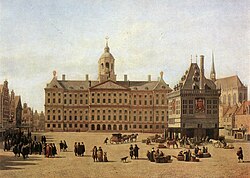
Back Столица на Нидерландия Bulgarian Πρωτεύουσα της Ολλανδίας Greek Hollandia fővárosa Hungarian Ibu kota Belanda ID ნიდერლანდების დედაქალაქი Georgian Hoofdstad van Nederland Dutch Capitala Țărilor de Jos Romanian Столица Нидерландов Russian


In the Netherlands, the Constitution refers to Amsterdam as the capital city. However, since 1588, the States General and the Executive Branch, along with the Supreme Court and the Council of State, have been situated in The Hague as the seat of government.[1][2] Since the 1983 revision of the Constitution of the Netherlands, Article 32 mentions that "the King shall be sworn in and inaugurated as soon as possible in the capital city, Amsterdam".[3][4] It is the only reference in the document stating that Amsterdam is the capital. In contrast, The Hague is customarily called the residentie ("residence").
Only once during its history was Amsterdam both "capital" and seat of government. Between 1808 and 1810, during the Kingdom of Holland, King Louis Napoleon resided in Amsterdam and declared the city capital of his kingdom and seat of government. To accommodate the king, the grand seventeenth-century Town Hall of Amsterdam, a prime example of the republican values that were prevalent for so long in the Netherlands, was converted into a Royal Palace.
In 1810, the Netherlands was annexed by the French Empire and King Louis Napoleon was replaced by a French governor, who took up residence in the Royal Palace in Amsterdam. From 1810 to 1813, Amsterdam kept its position of capital city somewhat, as Emperor Napoleon declared the city to be the third city of the Empire (after Paris and Rome) and an imperial residence. In December 1813, after the fall of Napoleon and the accession of Prince William VI of Orange as Sovereign of the Netherlands, The Hague was restored as the seat of government.
- ^ Dutch Wikisource. "Grondwet voor het Koninkrijk der Nederlanden" [Constitution for the Kingdom of the Netherlands] (in Dutch). Chapter 2, Article 32. Retrieved 7 January 2018.
... de hoofdstad Amsterdam ...
- ^ Daum, Andreas (2005). Berlin–Washington, 1800–2000 Capital Cities, Cultural Representation, and National Identities. Cambridge University Press. pp. 13, 38. ISBN 0521841178.
Amsterdam is the statuary capital of the Netherlands, while the Dutch government resides in De Hague. [sic]" (p. 13) "The Netherlands' seat of government is The Hague but its capital is bustling Amsterdam, the national cultural center. (p. 38)
- ^ "Grondwet voor het Koninkrijk der Nederlanden (1983)" (in Dutch). Retrieved 2016-12-06.
- ^ "The Constitution of the Kingdom of the Netherlands 2008". 18 October 2012. Retrieved 2016-12-06.